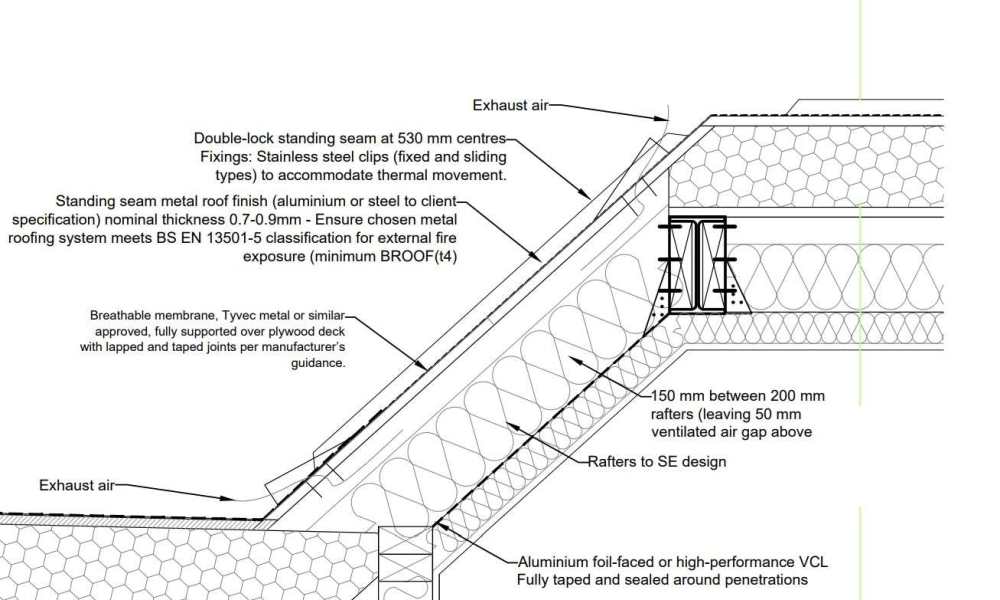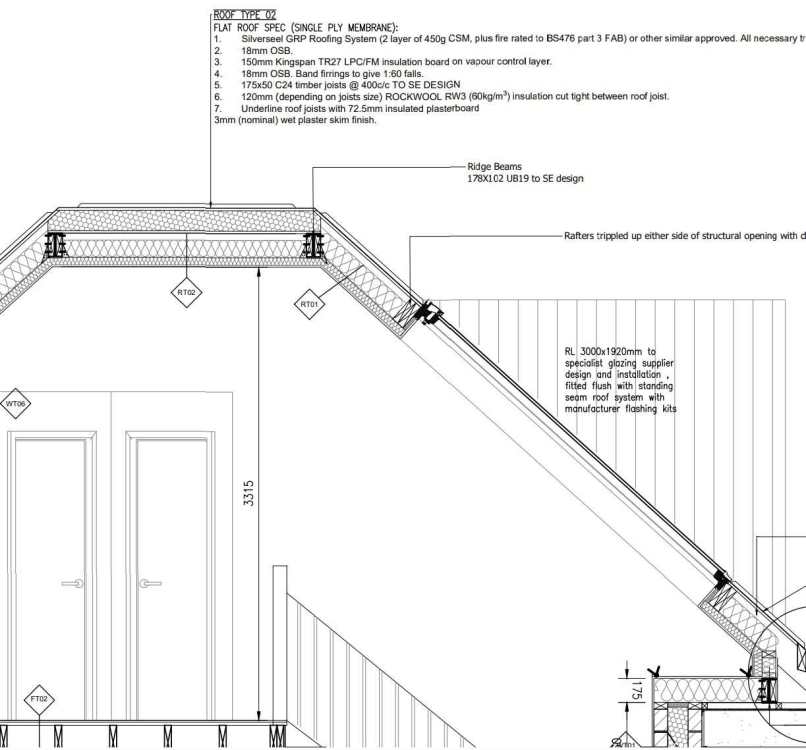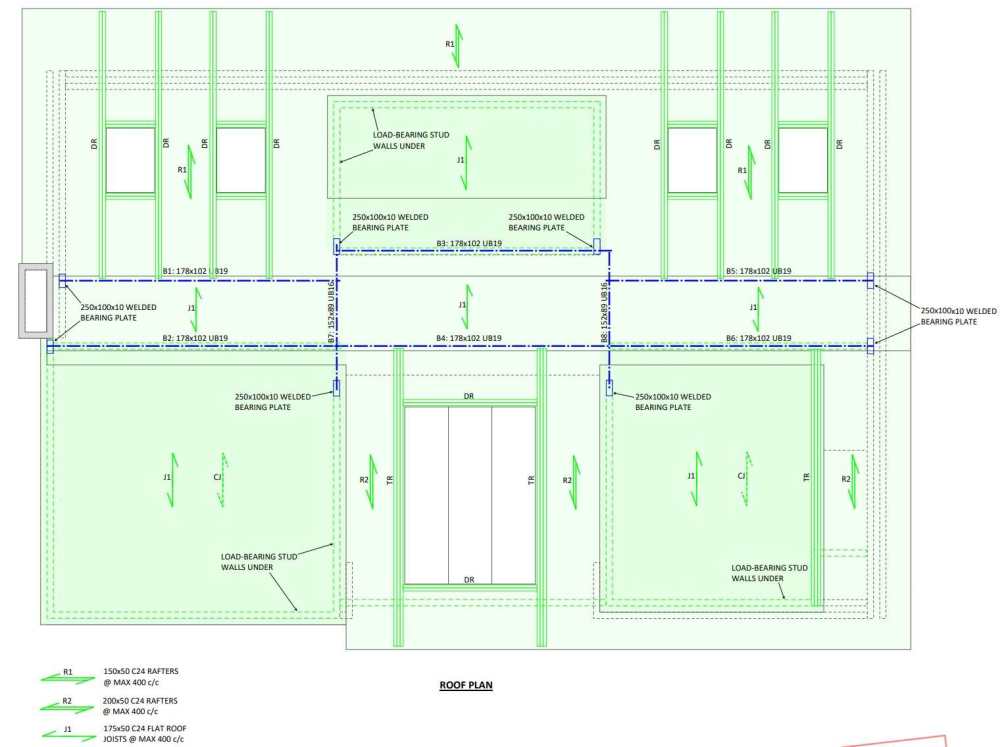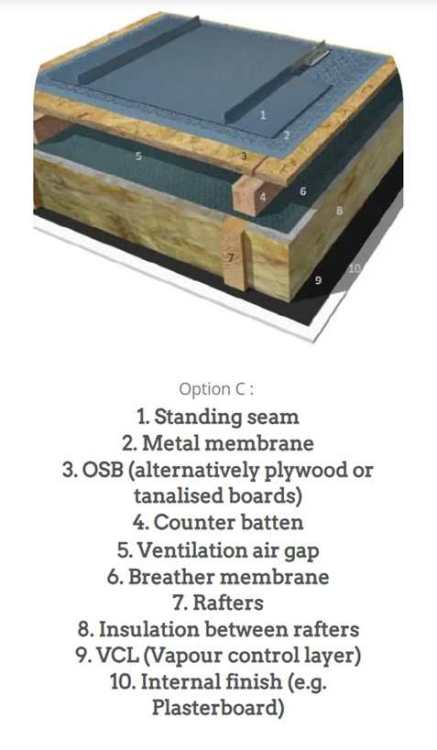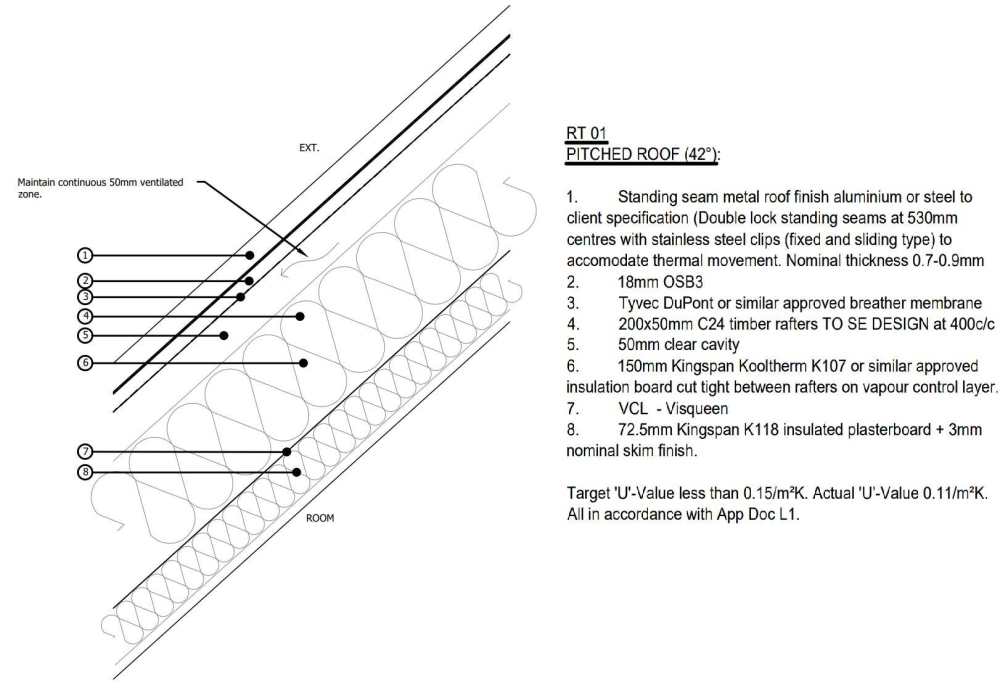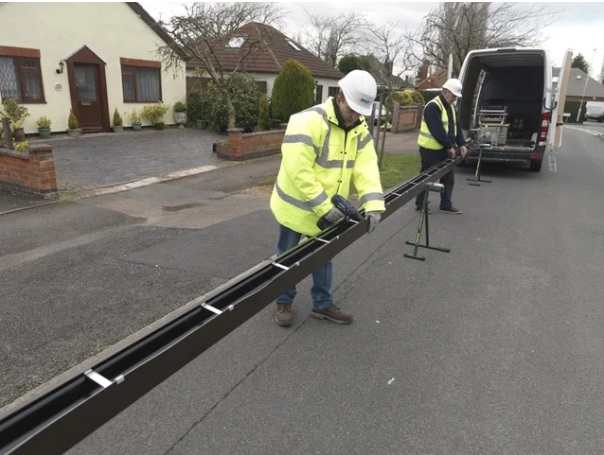-
Posts
284 -
Joined
-
Last visited
Everything posted by Tony L
-
Thanks for the reminder - same probably goes for GRP, which I may end up with. I understand GRP can be very noisy as it expands & shrinks, although expansion ridges can be built in to mitigate this. My arch tec has specified phenolic insulation for the sloped roof, which I suspect is almost as bad at providing noise insulation as PIR. He's specified PIR under the GRP flat roof.
- 15 replies
-
- standing seam roof
- pitched roof
-
(and 1 more)
Tagged with:
-
What improvements could I suggest? One solution would be to put the steels lower down, so their tops are where their bottoms have been drawn. This eats into my narrow vaulted ceiling space, but it could be a price worth paying. Another solution would be to have them lower by half the height of the steel & the sloped roof joists could then have a cut in to accommodate the steel, which the joists would rest on. I don’t think we could maintain the height of the steels & move them closer to one another (even just 100mm, to allow 100mm of insulation to be added), could we? I don’t know how we’d deal with the connection of the sloping roof joist ends if we did that – perhaps just by adding blocks of C24 where we already have C24 bolted into the steel I-beam, to make the connection to each joist end. I wish I had time to draw all these ideas. Perhaps I should be aiming for a warm flat roof with up to 200mm of PIR on top of the rafters.
- 15 replies
-
- standing seam roof
- pitched roof
-
(and 1 more)
Tagged with:
-
The detail picture shows the vent at the top of the standing seam is open to the rain – not just the odd raindrop - another drawing shows that all the rain from the flat roof will drains off both long edges (14m along the front of the house, 14m along the back of the house) onto the sloped roof. Surely this detail should show the flat roof edge overhanging the top of the standing seam (perhaps right on top of the seams) – so air just vents out where the standing seam finishes & rainwater from the flat roof drips onto the standing seam 80-100mm beyond the end of the standing seam?
- 15 replies
-
- standing seam roof
- pitched roof
-
(and 1 more)
Tagged with:
-
- 15 replies
-
- standing seam roof
- pitched roof
-
(and 1 more)
Tagged with:
-
There’s another aspect of the roof design I would also like to receive advice on. Due to the LA planning dept. limiting the ridge height, my roof design has two conventional sloping sides meeting at a flat roof running the full width of the house. The flat roof is 14200 x 1800mm. I am happy that the arch tec hasn’t drawn a parapet flat roof, but I don’t like the flat roof design he’s come up with, especially the way it interfaces with the sloping roof sections & the way the two steel ridge beams run the entire width of the house, with next to zero insulation on the outside edge & only 72mm insulated plasterboards across the whole of the bottom of 102mm wide steel beams. This looks like 28+ metres of unnecessary cold bridge to me. Am I right to be concerned about this? Maybe I shouldn’t worry about it & I should just focus on building something I can afford, & making sure it’s super air tight. What does everybody think? Here’s an early draft roof plan from my SE, showing steel beams, in dark blue.
- 15 replies
-
- standing seam roof
- pitched roof
-
(and 1 more)
Tagged with:
-
Thanks, @Russell griffiths & @Nick Laslett. I've watched quite a few of Steve Roofer's YT videos, but I hadn't seen that one. He's very good. This is so difficult - even an expert like Steve Roofer doesn't have all the answers. He's got tons of good ideas & he explains things very well, but rather than say, "Do it exactly like this.", he's saying (in this video), "Talk to the manufacturers.", to choose a suitable membrane. Very interesting that he recommends sandwiching the outer membrane between the battens & cross battens - so it's in the middle of the 50mm vent cavity under the tiles, standing seam or whatever - that idea wouldn't have occurred to me.
- 15 replies
-
- 1
-

-
- standing seam roof
- pitched roof
-
(and 1 more)
Tagged with:
-
Sorry, I'm too busy to dig that information out for you. I engaged him quite some time ago, although I have only recently received the full set of draft drawings that I was supposed to receive early in July. He came highly recommended by a prominent BH forum member.
- 15 replies
-
- standing seam roof
- pitched roof
-
(and 1 more)
Tagged with:
-
Thanks, @Russell griffiths & @saveasteading. Pagurek offer this make up, below, as one of their suggested options. I will perhaps choose to upgrade from OSB to wood. I'm not keen on ply as it warps so much when it dries out after becoming damp. I'm happy enough with the standing seam above the 50mm air gap. It's the other aspects of the roof build up I need help with, please.
- 15 replies
-
- standing seam roof
- pitched roof
-
(and 1 more)
Tagged with:
-
Well, yes, if you're not going to do it yourself, then you'll have to pay somebody to do it. You could get an M&E consultant, such as @Nickfromwales, who posts here a lot, to do the whole lot, or you might get one company to deal with CH & hot water, & a separate company to deal with MVHR, if that's what you're having. & if you're not having MVHR, I should think you just need to mention the trickle vents in the windows & give the spec' of the extractors in the bathrooms & kitchen. Somebody who knows a lot more than me will be along to help you out tomorrow.
-
If I increase to a 300mm I-joist, the U-value comes down to around 0.129 W/m2K. The arch tec’s roof is just 290mm thick, which is useful. The notes say it has a U-value of 0.11W/m2K. Actually, it says “0.11/m2K”, because he missed the “W” (Watts). Another thing he’s done, just to confuse us all, is he’s used label numbers that don’t correspond to the positions of the materials within the roof make up – so number 1 is the standing seam layer, on the outside, but number 5 (50mm air cavity) sits on top of the rafters (number 4) & the insulation between the rafters (number 6). Confused? I am. I think he’s drawn the Tyvek membrane on top of the 50mm cavity, rather than beneath it, & he hasn’t spec’d the battens for the 50mm cavity; should he have? Perhaps, 50 x 50mm C24 battens should be specified? I don’t know. I can’t find K107 & K118 in Ubakus, so I haven’t checked the arch tec’s 0.11W/m2K U-value for his roof design. I don’t like the look of the arch tec’s design. I don’t like the idea of cutting boards in between the rafters (ie relying on somebody else to do it properly) & I suspect the K118 might be off-gassing more poison than my design too. I think the arch tec’s roof may be more expensive (just on materials) than the design I proposed, & it will be significantly more expensive once the labour is factored in. Have I got that right? So far, I haven’t found time to get all the prices & work it all out. What do you think I should be saying to the arch tec about the roof make up?
- 15 replies
-
- standing seam roof
- pitched roof
-
(and 1 more)
Tagged with:
-
I’ve had a go at plugging my I-joist based design into Ubakus. I couldn’t find most of the materials I wanted to use & Ubakus won’t let me have my battens for the interior plaster board running the other way from the joists, unless I pay a subscription, but this gives me a rough idea of how my 240mm I-joist roof option might perform:
- 15 replies
-
- standing seam roof
- pitched roof
-
(and 1 more)
Tagged with:
-
I’d very much appreciate some opinions on this roof design please: I’ve designed a house myself (with no prior knowledge). I have planning permission. An architectural technician has recently prepared a full set of building regulations & construction drawings for me - ie one set of drawings will go to the SE for his input, then to BC for approval, then to builders. Now I’m working through the draft drawings, to make sure I’m happy with all the decisions the arch tec has made. My brief for the sloping roof sections was: standing seam on special SS membrane, then OSB, then 50mm air gap, more OSB, I-joists at 600 centres & Warmcel blown cellulose in between. I suggested 300mm deep I-joists or next size down (240mm), if we’re struggling to make everything fit (there’s a PP ridge height restriction). Also, I’d seen some of the arch tec’s drawings for another project (with phenolic everywhere) so I told him, to keep costs down, we should only use phenolic in one very small area where we need to avoid bulky insulation. He’s specified two layers of phenolic, over the entire sloping roof. My own (240mm I-joist based) roof design would be about 354mm thick – so, compared to the arch tec’s roof design, my design significantly reduces the space in two of my in-roof bedrooms, which don’t have dormers. The extra depth of the I-joist solution will be why he’s done drawn something that doesn’t fit with my brief. Here’s the arch tec’s design:
- 15 replies
-
- standing seam roof
- pitched roof
-
(and 1 more)
Tagged with:
-
-
Payment Terms - Pay everything upfront?
Tony L replied to Mulberry View's topic in General Self Build & DIY Discussion
The prospect of a Section 75 claim, if your contract allows for payments to be made by credit card. Has anybody here ever made a Section75 claim? How did it go? -
Thank you @saveasteading & @Mike. I got about half way through the video. You're right - it's not at all exciting. I'll watch the rest tomorrow. It hadn't occurred to me that a QS might help me evaluate the builders' quotes. There's a lot to think about here. Asking about the BoQ & cost estimate has raised more questions than I expected. I probably ought to leave this for now & focus on getting my drawings completed.
-
That's good to know - thanks. I've never seen a BoC, & I was concerned there may be pitfalls to look out for. I am very wary because, although I'm still in the early stages, I have been let down very badly by many of the people who have worked on my project so far & this has caused thousands of pounds of extra spend & months of delays. Yes, I will buy a cost estimate add-on as part of the QS work. I may make some changes to the design or specification, based on the QS cost estimate. & your point about the estimates is well made, although I will be asking for quotations, rather than estimates.
-
Thanks, @Dave Jones. For this, I guess I need the bill of quantities to be presented in order, with sub-totals for each stage. Some self builders have shared their BC/construction drawings, & this has been invaluable to me in enabling me to tell my architectural technician where he's gone wrong. I can't find an example of what you get when you've paid for QS, anywhere. If anybody would be willing to send me a copy of their reports, I'd be very grateful. Are mybuildestimate.co.uk a good example of a professional QS company, or are there superior professional QS companies out there? Any recommendations would be very welcome. Do these QS companies get almost everything right the first time they issue their reports, or is there often much work required by the client to get them to do their work properly, as has been my experience with my BCO/construction drawings?
-
Best on blocks, I'd say. We had ours installed by the dealer we bought the 'van from, & they told me to get the ground as level as possible & have plenty of blocks to hand. Perhaps they fine tuned the levels with off cuts of wood & old slates - I don't remember now.
-
if I remember correctly
-
Aluminium Gutters / Soffits - Who to use?
Tony L replied to boxrick's topic in Roofing, Tiling & Slating
I don't know which part of the country you're in, @boxrick. I've saved the details of a company in, Purley/Croydon, called Bespoke Guttering. They manufacture on site, from a roll, so you end up with a seamless gutter. They do fascias & soffits too. Presumably, they offer downpipes as well. I'm way off the guttering stage of my build, so this isn't a recommendation, but you may want to consider them if you're not too far away. Here's a picture from their website: -
Interesting. Thanks, I didn't know that. It wasn't one of my conditions, but they did put this in next door's conditions (for PP to demolish & rebuild - same as me).
-
Also consider that PP is often granted with a condition that the property will no longer have PD rights. This probably doesn't help you, @Leigh0403, but the best thing to do is to get your outbuildings up before PP is granted (assuming they qualify as PD & they're not going to get in the way of the main build).
-
Vat claim
Tony L replied to nod's topic in Self Build VAT, Community Infrastructure Levy (CIL), S106 & Tax
Thanks for explaining your VAT reclaim, @nod. It's good to know they don't enforce the silly wardrobe rule, although a different inspector may have taken a different view. -
The natural wood colour looks the best of those two pictures. It suits the house. Normally, I prefer black, but it needs to be on the right kind of house. With black, you can be confident it’s going to retain the same look for many years. With the natural wood, anything can happen – perhaps not, if you really know what you’re doing, but it seems most people don’t know (or perhaps the builders just don’t care). I don’t like it when natural wood cladding turns grey. I see a lot of wood cladding weathers badly & can look damp towards the bottom. I particularly dislike the “damp at the bottom” look I see on a lot of natural wood cladding – it looks just like a cheap garden shed to me, & that’s not a great look for a house.


